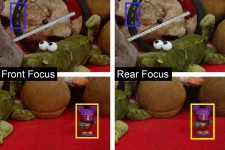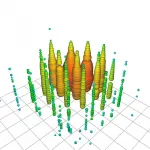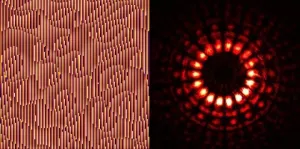INFORMATION:
The work was supported, in part, by Sony.
Written by Daniel Ackerman, MIT News Office
Using artificial intelligence to generate 3D holograms in real-time
A new method called tensor holography could enable the creation of holograms for virtual reality, 3D printing, medical imaging, and more -- and it can run on a smartphone.
2021-03-10
(Press-News.org) Despite years of hype, virtual reality headsets have yet to topple TV or computer screens as the go-to devices for video viewing. One reason: VR can make users feel sick. Nausea and eye strain can result because VR creates an illusion of 3D viewing although the user is in fact staring at a fixed-distance 2D display. The solution for better 3D visualization could lie in a 60-year-old technology remade for the digital world: holograms.
Holograms deliver an exceptional representation of 3D world around us. Plus, they're beautiful. (Go ahead -- check out the holographic dove on your Visa card.) Holograms offer a shifting perspective based on the viewer's position, and they allow the eye to adjust focal depth to alternately focus on foreground and background.
Researchers have long sought to make computer-generated holograms, but the process has traditionally required a supercomputer to churn through physics simulations, which is time-consuming and can yield less-than-photorealistic results. Now, MIT researchers have developed a new way to produce holograms almost instantly -- and the deep learning-based method is so efficient that it can run on a laptop in the blink of an eye, the researchers say.
"People previously thought that with existing consumer-grade hardware, it was impossible to do real-time 3D holography computations," says Liang Shi, the study's lead author and a PhD student in MIT's Department of Electrical Engineering and Computer Science (EECS). "It's often been said that commercially available holographic displays will be around in 10 years, yet this statement has been around for decades."
Shi believes the new approach, which the team calls "tensor holography," will finally bring that elusive 10-year goal within reach. The advance could fuel a spillover of holography into fields like VR and 3D printing.
Shi worked on the study, published in Nature, with his advisor and co-author Wojciech Matusik. Other co-authors include Beichen Li of EECS and the Computer Science and Artificial Intelligence Laboratory at MIT, as well as former MIT researchers Changil Kim (now at Facebook) and Petr Kellnhofer (now at Stanford University).
The quest for better 3D
A typical lens-based photograph encodes the brightness of each light wave -- a photo can faithfully reproduce a scene's colors, but it ultimately yields a flat image.
In contrast, a hologram encodes both the brightness and phase of each light wave. That combination delivers a truer depiction of a scene's parallax and depth. So, while a photograph of Monet's "Water Lilies" can highlight the paintings' color palate, a hologram can bring the work to life, rendering the unique 3D texture of each brush stroke. But despite their realism, holograms are a challenge to make and share.
First developed in the mid-1900s, early holograms were recorded optically. That required splitting a laser beam, with half the beam used to illuminate the subject and the other half used as a reference for the light waves' phase. This reference generates a hologram's unique sense of depth. The resulting images were static, so they couldn't capture motion. And they were hard copy only, making them difficult to reproduce and share.
Computer-generated holography sidesteps these challenges by simulating the optical setup. But the process can be a computational slog. "Because each point in the scene has a different depth, you can't apply the same operations for all of them," says Shi. "That increases the complexity significantly." Directing a clustered supercomputer to run these physics-based simulations could take seconds or minutes for a single holographic image. Plus, existing algorithms don't model occlusion with photorealistic precision. So Shi's team took a different approach: letting the computer teach physics to itself.
They used deep learning to accelerate computer-generated holography, allowing for real-time hologram generation. The team designed a convolutional neural network -- a processing technique that uses a chain of trainable tensors to roughly mimic how humans process visual information. Training a neural network typically requires a large, high-quality dataset, which didn't previously exist for 3D holograms.
The team built a custom database of 4,000 pairs of computer-generated images. Each pair matched a picture -- including color and depth information for each pixel -- with its corresponding hologram. To create the holograms in the new database, the researchers used scenes with complex and variable shapes and colors, with the depth of pixels distributed evenly from the background to the foreground, and with a new set of physics-based calculations to handle occlusion. That approach resulted in photorealistic training data. Next, the algorithm got to work.
By learning from each image pair, the tensor network tweaked the parameters of its own calculations, successively enhancing its ability to create holograms. The fully optimized network operated orders of magnitude faster than physics-based calculations. That efficiency surprised the team themselves.
"We are amazed at how well it performs," says Matusik. In mere milliseconds, tensor holography can craft holograms from images with depth information -- which is provided by typical computer-generated images and can be calculated from a multicamera setup or LiDAR sensor (both are standard on some new smartphones). This advance paves the way for real-time 3D holography. What's more, the compact tensor network requires less than 1 MB of memory. "It's negligible, considering the tens and hundreds of gigabytes available on the latest cell phone," he says.
"A considerable leap"
Real-time 3D holography would enhance a slew of systems, from VR to 3D printing. The team says the new system could help immerse VR viewers in more realistic scenery, while eliminating eye strain and other side effects of long-term VR use. The technology could be easily deployed on displays that modulate the phase of light waves. Currently, most affordable consumer-grade displays modulate only brightness, though the cost of phase-modulating displays would fall if widely adopted.
Three-dimensional holography could also boost the development of volumetric 3D printing, the researchers say. This technology could prove faster and more precise than traditional layer-by-layer 3D printing, since volumetric 3D printing allows for the simultaneous projection of the entire 3D pattern. Other applications include microscopy, visualization of medical data, and the design of surfaces with unique optical properties.
"It's a considerable leap that could completely change people's attitudes toward holography," says Matusik. "We feel like neural networks were born for this task."
ELSE PRESS RELEASES FROM THIS DATE:
IceCube detection of a high-energy particle proves 60-year-old theory
2021-03-10
On December 6, 2016, a high-energy particle called an electron antineutrino hurtled to Earth from outer space at close to the speed of light carrying 6.3 petaelectronvolts (PeV) of energy. Deep inside the ice sheet at the South Pole, it smashed into an electron and produced a particle that quickly decayed into a shower of secondary particles. The interaction was captured by a massive telescope buried in the Antarctic glacier, the IceCube Neutrino Observatory.
IceCube had seen a Glashow resonance event, a phenomenon predicted by Nobel laureate physicist ...
Finding quvigints in a quantum treasure map
2021-03-10
Researchers have struck quantum gold--and created a new word--by enlisting machine learning to efficiently navigate a 20-dimensional quantum treasure map.
Physicist Dr Markus Rambach from the ARC Centre of Excellence for Engineered Quantum Systems (EQUS) at The University of Queensland said the team was able to find unknown quantum states more quickly and accurately, using a technique called self-guided tomography.
The team also introduced the 'quvigint', which is like a qubit (the quantum version of a classical bit that takes on the values '0' or '1') except that it takes on not two, but 20 possible values.
Dr ...
Risk factors associated With SARS-CoV-2 seropositivity among US health care personnel
2021-03-10
What The Study Did: In this study, most risk factors associated with SARS-CoV-2 infection among health care workers were outside the workplace.
Authors: Jesse T. Jacob, M.D., of Emory University in Atlanta, is the corresponding author.
To access the embargoed study: Visit our For The Media website at this link https://media.jamanetwork.com/
(doi:10.1001/jamanetworkopen.2021.1283)
Editor's Note: The article includes conflict of interest and funding/support disclosures. Please see the article for additional information, including other authors, author contributions and affiliations, conflict of interest and financial disclosures, and funding and support.
INFORMATION:
Media ...
IceCube detection of high-energy particle proves 60-year-old physics theory
2021-03-10
MADISON - On December 6, 2016, a high-energy particle hurtled to Earth from outer space at close to the speed of light. The particle, an electron antineutrino, smashed into an electron deep inside the ice sheet at the South Pole. This collision produced a particle that quickly decayed into a shower of secondary particles, triggering the sensors of the IceCube Neutrino Observatory, a massive telescope buried in the Antarctic glacier.
IceCube had seen a Glashow resonance event, a phenomenon predicted by Nobel laureate physicist Sheldon Glashow in 1960. With this detection, scientists provided another confirmation of the Standard Model of particle physics. It ...
SARS-CoV-2 seroprevalence, symptom onset in culturally linked orthodox Jewish communities across multiple US regions
2021-03-10
What The Study Did: This study of orthodox Jewisha dults across the United States found that socioculturally bound communities experienced early parallel outbreaks in discrete locations, notably prior to substantive medical and governmental directives.
Authors: Jonathan I. Silverberg, M.D., Ph.D., M.P.H., of George Washington University in Washington, D.C., and Avi Z. Rosenberg, M.D., Ph.D., of Johns Hopkins University in Baltimore, are the corresponding authors.
To access the embargoed study: Visit our For The Media website at this link https://media.jamanetwork.com/
(doi:10.1001/jamanetworkopen.2021.2816)
Editor's Note: The article includes conflict of interest and funding/support disclosures. ...
Association of age with likelihood of developing symptoms, critical disease among close contacts exposed to patients with confirmed SARS-CoV-2 infection
2021-03-10
What The Study Did: In a study of Italian close contacts of patients with confirmed SARS-CoV-2 infection, most infected contacts (1,948 of 2,824 individuals or 69%) didn't develop respiratory symptoms or fever 37.5 degrees Celsius (99.5 degrees Fahrenheit) or higher; 26.1% of infected individuals younger than 60 developed respiratory symptoms or fever 37.5 degrees Celsius (99.5 degrees Fahrenheit); and 6.6% of infected participants age 60 or older developed critical disease.
Authors: Piero Poletti, Ph.D., of Fondazione Bruno Kessler in Trento, ...
Implementation of recuperation unit, hospitalization rates among people experiencing homelessness with COVID-19
2021-03-10
What The Study Did: Boston experienced a COVID-19 surge that disproportionately affected persons experiencing homelessness and a large safety-net hospital implemented a novel COVID-19 recuperation unit for these patients that provided isolation, quarantine and treatment for substance use. Researchers aimed to determine the association of the care provided by the unit with COVID-19 hospitalizations among people experiencing homelessness.
Authors: Joshua A. Barocas, M.D., of Boston Medical Center, is the corresponding author.
To ...
Assessment of acute kidney injury, longitudinal kidney function after hospital discharge among patients with, without COVID-19
2021-03-10
What The Study Did: Findings of this study suggest that patients recovering from COVID-19-associated acute kidney injury require monitoring of kidney function following hospital discharge.
Authors: F. Perry Wilson, M.D. M.S.C.E., of the Yale University School of Medicine in New Haven, Connecticut, is the corresponding author.
To access the embargoed study: Visit our For The Media website at this link https://media.jamanetwork.com/
(doi:10.1001/jamanetworkopen.2021.1095)
Editor's Note: The article includes conflict of interest and funding/support disclosures. Please see the article for additional information, including other authors, author ...
Placenta is a dumping ground for genetic defects
2021-03-10
In the first study of the genomic architecture of the human placenta, scientists at the Wellcome Sanger Institute, the University of Cambridge and their collaborators have confirmed that the normal structure of the placenta is different to any other human organ and resembles that of a tumour, harbouring many of the same genetic mutations found in childhood cancers.
The study, published today (10 March 2021) in Nature, found evidence to support the theory of the placenta as a 'dumping ground' for genetic defects, whereas the fetus corrects or avoids these errors. The findings provide a clear rationale for studying the association between genetic aberrations and birth outcomes, in order to better understand problems such as premature birth and stillbirth.
In the earliest ...
Characteristics, mortality associated with diabetic ketoacidosis among us patients hospitalized with,without COVID-19
2021-03-10
What The Study Did: Researchers analyzed individual-level inpatient data from multiple U.S. hospital to further describe patients with diabetic ketoacidosis (a life-threatening complication of diabetes) with and without COVID-19.
Authors: Francisco J. Pasquel, M.D., M.P.H., of the Emory University School of Medicine in Atlanta, is the corresponding author.
To access the embargoed study: Visit our For The Media website at this link https://media.jamanetwork.com/
(doi:10.1001/jamanetworkopen.2021.1091)
Editor's Note: The article ...
LAST 30 PRESS RELEASES:
Numbers in our sights affect how we perceive space
SIMJ announces global collaborative book project in commemoration of its 75th anniversary
Air pollution exposure and birth weight
Obstructive sleep apnea risk and mental health conditions among older adults
How talking slows eye movements behind the wheel
The Ceramic Society of Japan’s Oxoate Ceramics Research Association launches new international book project
Heart-brain connection: international study reveals the role of the vagus nerve in keeping the heart young
Researchers identify Rb1 as a predictive biomarker for a new therapeutic strategy in some breast cancers
Survey reveals ethical gaps slowing AI adoption in pediatric surgery
Stimulant ADHD medications work differently than thought
AI overestimates how smart people are, according to HSE economists
HSE researchers create genome-wide map of quadruplexes
Scientists boost cell "powerhouses" to burn more calories
Automatic label checking: The missing step in making reliable medical AI
Low daily alcohol intake linked to 50% heightened mouth cancer risk in India
American Meteorological Society announces Rick Spinrad as 2026 President-Elect
Biomass-based carbon capture spotlighted in newly released global climate webinar recording
Illuminating invisible nano pollutants: advanced bioimaging tracks the full journey of emerging nanoscale contaminants in living systems
How does age affect recovery from spinal cord injury?
Novel AI tool offers prognosis for patients with head and neck cancer
Fathers’ microplastic exposure tied to their children’s metabolic problems
Research validates laboratory model for studying high-grade serous ovarian cancer
SIR 2026 delivers transformative breakthroughs in minimally invasive medicine to improve patient care
Stem Cell Reports most downloaded papers of 2025 highlight the breadth and impact of stem cell research
Oxford-led study estimates NHS spends around 3% of its primary and secondary care budget on the health impacts of heat and cold in England
A researcher’s long quest leads to a smart composite breakthrough
Urban wild bees act as “microbial sensors” of city health.
New study finds where you live affects recovery after a hip fracture
Forecasting the impact of fully automated vehicle adoption on US road traffic injuries
Alcohol-related hospitalizations from 2016 to 2022
[Press-News.org] Using artificial intelligence to generate 3D holograms in real-timeA new method called tensor holography could enable the creation of holograms for virtual reality, 3D printing, medical imaging, and more -- and it can run on a smartphone.


